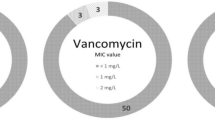Summary
The analysis of differences in occurrence of antibiotic-resistant strains belonging to ten species of “problem” bacteria was performed by means of a computer program in more than 150,000 bacterial strains isolated in Slovakia in 1977. In all respects, strains isolated in general medical practice were considerably more sensitive to classical as well as to newer antibiotics. Marked differences in resistance within individual medical services could be a reflection of both quantitative and qualitative aspects of the use of a given antibiotic. Urological and surgical wards, and in some respects pediatric and infectious diseases services, rendered the highest percentage of strains resistant to various drugs. There are still several antibiotics which are effective in vitro against staphylococci, while gentamicin, colistin and cotrimoxazole are the only antibiotics displaying more general activity against gram-negative “problem” bacteria. Nevertheless, strains from general practice show a good response in vitro, even to older antibiotics, despite the fact that these have been widely used for decades in general practice.
Zusammenfassung
Die Analyse des unterschiedlichen Vorkommens von antibiotika-resistenten Stämmen, die zu zehn Spezies von „Problem“-Bakterien gehören, wurde mit Hilfe eines Computerprogrammes bei mehr als 150 000 Bakterienstämmen durchgeführt, die 1977 in der Slowakei isoliert wurden. In jeder Beziehung waren die Stämme, die in der Allgemeinpraxis isoliert wurden, wesentlich empfindlicher gegenüber den klassischen und neueren Antibiotika. Bedeutende Unterschiede in der Resistenz-Situation zwischen den einzelnen medizinischen Versorgungsbereichen könnten quantitative und qualitative Aspekte der Verwendung eines bestimmten Antibiotikums wiederspiegeln. Urologische und chirurgische Stationen und zum Teil pädiatrische und Infektionsabteilungen übersandten den höchsten Prozentsatz von gegenüber verschiedenen Substanzen resistenten Stämmen. Es gibt immer noch mehrere Antibiotika, die in vitro gegen Staphylokokken wirksam sind, während Gentamicin, Colistin und Cotrimoxazol die einzigen Antibiotika sind, die eine breitere Aktivität gegen gramnegative „Problem“-Bakterien aufweisen. Desungeachtet zeigen Stämme aus der Allgemeinpraxis eine gute Ansprechbarkeit in vitro, sogar gegenüber älteren Antibiotika, obwohl diese seit Jahrzehnten in der Allgemeinpraxis in großem Umfang verwendet worden sind.
Similar content being viewed by others
Literatur
Krčméry, V., Grunt, J., Rosival, L., Výmola, F. Nationwide survey of antibiotic resistance by means of a computer. Zbl. Bakteriol. (Orig. A) 231 (1975) 250–258.
Grunt, J., Krčméry, V. An introduction into analysis of multiple antibiotic resistance. Zbl. Bakteriol. (Orig. A) 232 (1975) 521–533.
Krčméry, V., Grunt, J. Nationwide survey of antibiotic resistance: Bacterial strains from the urine, stool and U. R. T. Zbl. Bakteriol. (Orig. A) 233 (1975) 99–105.
Grunt, J., Krčméry, V. Multiple-drug resistance inKlebsiella, Enterobacter andP. aeruginosa. Zbl. Bakteriol. 236 (1976) 105–112.
Grunt, J., Krčméry, V., Rosival, L., Calpaš, Š. Computer survey of antibiotic resistance — Developments during 1973 to 1977. Zbl. Bakteriol. (Orig. A) 242 (1978) 239–244.
Grunt, J., Krčméry, V., Rosival, L. Monitoring bacterial resistance to restricted antibiotics. Amer. J. Hosp. Pharm. 35 (1978) 1387–90.
Grunt, J., Krčméry, V. Rosival, L., Výmola, F. Antibiotic policy. In:Mitsuhashi, S., Krčméry, V. Rosival, L. (ed): Plasmids. Avicenum and Springer Verlag, Praha-Heidelberg, 1977 p. 11–16.
Wagner, W. H. Die gegenwärtige Resistenzsituation. Immun. Infekt. 6 (1978) 180–193.
Devaud, M., Kayser, F. H., Huber, U. Resistance to newer aminoglycosides: An epidemiological and enzymatic study. J. Antibiot. 30 (1977) 655–664.
Knothe, H., Krčméry, V. Transferable gentamicin-tobramycin-netilmicin-amikacin resistance inP. aeruginosa. In:Siegenthaler, W., Lüthy, R., Current Chemotherapy. American Society of Microbiology, Washington, 1978 p. 893–895.
Anderson, E. S., Discussion. In:Drews, J., Hogenauer, G. R. factors, their properties and possible control. Springer, Wien, 1977, p. 22: “The use of antibiotics as is now practised in the community,is the calamity. It's an act of complacency to say we have reached a steady-state and we do not have to worry.We do need to worry! ...”
Author information
Authors and Affiliations
Rights and permissions
About this article
Cite this article
Krčméry, V., Grunt, J., Osival, L. et al. Antibiotic resistance in various medical services. Infection 7 (Suppl 2), S216–S219 (1979). https://doi.org/10.1007/BF01641126
Issue Date:
DOI: https://doi.org/10.1007/BF01641126




